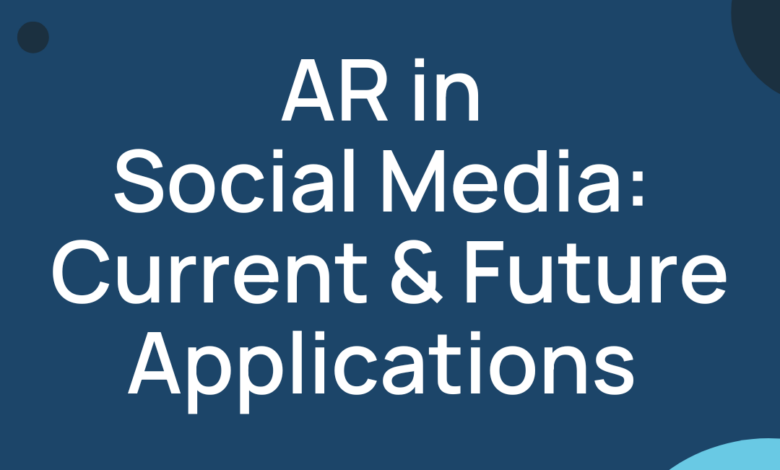AR in Social Media: Current & Future Applications

Augmented Reality, or AR, is changing how we see and interact with the world. It’s a technology that mixes digital information with the real world. Unlike Virtual Reality (VR), which creates a totally artificial environment, AR uses the existing environment and overlays new information on top of it.
Today, AR is more than just a cool feature in games or apps; it’s a tool that’s reshaping entire industries. From healthcare and education to retail and entertainment, AR is making big waves. But one area where AR really stands out is in social media.
In social media, AR is transforming how we connect, share, and even market products. It’s not just about posting photos and videos anymore. Now, we can add digital elements like filters, animations, and interactive features to our social media content. This makes sharing experiences more fun and engaging. It also opens up innovative ways for brands to engage with consumers, revolutionizing social media marketing.
- What is Augmented Reality (AR)?
- How is AR Currently Being Used in Social Media?
- Benefits of AR in Social Media Marketing
- Potential Challenges and Ethical Considerations With AR
- Measuring AR’s Impact on Social Media Campaigns
- Future Applications of AR in Social Media
- Examples of Successful Use of AR on Social Channels
What is Augmented Reality (AR)?
Augmented Reality (AR) is a technology that blurs the line between the physical world and digital information. It lets us see the real world, but with digital images or information overlaid on it. Imagine looking through your phone’s camera and seeing a virtual object, like a piece of furniture, appear in your room. That’s AR in action.
AR is different from Virtual Reality (VR). While VR takes you to a completely different, computer-generated world, AR simply adds to the reality you’re already in. VR needs a headset to replace your vision with a digital world, but AR can be experienced with just a smartphone or smart glasses, adding to what you’re already seeing.
A Brief History of the AR Journey So Far
The journey of AR started in the 1960s with the first head-mounted display system. But it was only in the late 1990s and early 2000s that AR started to gain traction, especially with advancements in mobile technology. The real turning point came when smartphones with advanced cameras and processing power became widespread.
AR technology relies on several key components:
- Computer Vision: This is what lets AR systems understand what they’re looking at. Using the camera on your device, AR software can identify objects and surfaces in the real world.
- 3D Rendering: Once AR software understands the environment, it renders (or draws) 3D images on the device’s screen or through special glasses. This makes the virtual objects look like they’re part of the real world.
- Sensors and Orientation Tracking: These are crucial for keeping the digital and real worlds aligned. Sensors in your device track movements and adjust the AR images accordingly, so they stay in place as you move around.
- User Interaction: AR is interactive. It lets you interact with both the real and virtual environments, offering a unique and immersive experience.
How is AR Currently Being Used in Social Media?
Augmented Reality (AR) has swiftly integrated into social media, transforming the way we interact online. The AR market is experiencing rapid growth, with its estimated market value projected to reach $50 billion by 2024.
Social media platforms are increasingly using AR to create immersive and interactive experiences for users. This integration is not just a novelty; it’s reshaping the dynamics of social interaction and content creation.
Integration of AR and Social Media Platforms
Social media giants are incorporating AR to enhance user experience. It’s used for everything from face filters and animations to interactive games and virtual try-ons.
These features are accessible through smartphone cameras, making AR experiences instantly shareable.
Examples of AR Features in Popular Social Media Apps
Snapchat:
Known for pioneering AR in social media, Snapchat offers a wide range of AR filters, also known as Lenses. These Lenses can change a user’s appearance, incorporate interactive elements, and even change the environment within the camera view.
Instagram and Facebook:
These platforms have followed suit with their own AR filters in stories and posts. Users can choose from an array of effects, from simple face alterations to complex scenery changes.
TikTok:
This platform has integrated AR features that allow users to add interactive and 3D elements to their videos, enhancing the storytelling aspect.
Impact of AR on User Engagement and Content Creation
AR features on social media platforms drive higher user engagement. Users spend more time on the app, interact more with the content, and are more likely to share AR-enhanced posts.
AR tools also empower users to become content creators, offering them new ways to express themselves and tell stories. This democratization of content creation has led to a surge in innovative and personalized content.
For brands, AR provides a unique way to engage with consumers. From virtual product try-ons to interactive marketing campaigns, AR is opening new avenues for brands to connect with their audience.
Benefits of AR in Social Media Marketing
Even in its relatively early stages, the integration of Augmented Reality (AR) in social media has already brought a ton of benefits, significantly enhancing user experience and engagement.
Enhanced User Experience and Engagement
AR creates an immersive experience that captivates users. By blending the digital and real worlds, it provides a more engaging way to interact with content.
Users can personalize their experiences with AR features, like filters and effects, making social media interactions more enjoyable and unique. The interactive nature of AR keeps users engaged for longer periods, increasing the time they spend on social media apps.
Opportunities for Creative Content Creation
AR tools have democratized content creation, allowing users to easily create and share innovative and visually appealing social content. It also enables a variety of content formats, from simple photo enhancements to complex interactive scenarios, catering to different creative tastes and skills.
With AR, users can tell stories in more dynamic and expressive ways, adding layers of context and emotion that were previously not possible. This also makes potential brand interactions far more dynamic and engaging.
Improved Accessibility and Interactive Advertising:
AR features are often integrated into smartphones, making them easily accessible to a wide user base without the need for additional hardware.
For advertisers, AR offers interactive ad formats that are more engaging than traditional ads. Users can interact with products virtually, leading to higher engagement rates. For example, it allows for virtual try-ons and previews of products, improving the online shopping experience and aiding decision-making.
In digital marketing campaigns, 67% of media planners and buyers express a desire to incorporate more AR/VR into their ads, reflecting the growing interest in using AR for innovative and engaging advertising strategies.
Brands can leverage AR to create unique, immersive experiences that resonate more deeply with users, fostering better engagement and brand recall. A notable 61% of consumers say they prefer retailers that offer AR experiences. This preference is driving retailers to integrate AR into their customer experiences, especially in the online shopping domain
Potential Challenges and Ethical Considerations With AR
Technical Challenges
Not all devices are equipped to handle the advanced AR features, which can limit user access and experience. AR applications can be data-intensive and may not perform optimally on slower internet connections or older devices, impacting user experience.
Ensuring the accuracy and reliability of AR technology, especially in real-time applications, also remains a significant technical challenge.
Ethical Concerns
AR technology often requires access to cameras and location data, raising concerns about user privacy and the potential misuse of personal information. With the increased data AR apps collect, ensuring the security of this information against breaches is crucial.
The realistic nature of AR content can blur the lines between reality and digital enhancement, potentially impacting mental health and body image perceptions.
The Digital Divide and Accessibility Issues
The digital divide is evident in the varying levels of access to AR-enabled devices and high-speed internet across different socio-economic and geographic groups.
Ensuring that AR features are accessible to users with disabilities (e.g., visual or hearing impairments) is essential but also remains a challenge. There’s a need for more inclusive design practices to ensure that AR technology benefits a diverse user base, considering different age groups, cultures, and abilities.
Measuring AR’s Impact on Social Media Campaigns
Measuring the impact of AR in social media marketing involves tracking various metrics to assess engagement, reach, and conversion. Key performance indicators (KPIs) include:
- Engagement Metrics: Track interactions like likes, shares, comments, and time spent with AR content.
- Reach and Impressions: Measure the number of people who have seen the AR content and how often it’s been displayed.
- Conversion Rates: Evaluate how effectively AR content leads to desired actions, like website visits, sign-ups, or purchases.
- User Generated Content (UGC): Monitor content created by users interacting with AR features, which indicates brand engagement and reach.
- ROI Analysis: Compare the cost of AR campaign development and execution against the revenue or value it generates.
Understanding the true impact of integrating AR into your social media campaigns requires a deep understanding of your content’s performance. You can get automated insights into content performance, campaigns, and more with Locowise—including predictive analytics. Dive into everything from social media audits to in-depth client reporting today with a free trial.
Future Applications of AR in Social Media
The future of Augmented Reality (AR) in social media is poised to be dynamic and transformative. Major tech companies are heavily investing in AR. Facebook, for instance, has acquired 11 AR/VR companies, demonstrating the industry’s belief in AR’s potential. Similarly, Google and Apple have made significant investments and acquisitions in the AR space.
As technology evolves, AR is set to deepen its impact in many aspects of social networking and digital marketing. Here’s a look at some of the exciting predictions and emerging trends:
- AR in Live Events and Interactive Experiences
Virtual Participation in Live Events:
AR could enable users to virtually attend concerts, sports events, or conferences, providing immersive experiences from the comfort of their homes.
Interactive Shopping Experiences:
Social media platforms could integrate AR for virtual try-ons, 3D product previews, and interactive shopping sessions, transforming online retail.
- Potential for AR in Community Building and Global Connectivity
Enhanced Social Interactions:
AR can create more engaging and interactive social experiences, bridging the gap between digital and physical communities.
Global Connectivity:
AR could play a significant role in connecting people across the globe, allowing for shared experiences and cultural exchanges in a virtual yet realistic setting.
Educational and Cultural Experiences:
There’s potential for AR to facilitate educational content and cultural experiences, like virtual tours of historical sites or museums, directly via social media.
- AR’s Role in the Evolution of Digital Marketing:
Personalized Advertising:
AR can offer highly personalized and interactive advertising experiences, directly engaging consumers in a novel way.
Brand Storytelling:
Brands could leverage AR to tell their stories in a more engaging and interactive manner, creating memorable campaigns.
Influencer Marketing:
Influencers could use AR to create more engaging and authentic content, offering unique experiences to their followers.
- Advanced AR Technologies
Improved Tracking and Interaction:
Future developments in AR technology, like enhanced spatial awareness and hand tracking, could lead to more natural and intuitive interactions in AR spaces.
Wearable AR Technology:
The advancement and adoption of wearable AR technology, like AR glasses, could make AR experiences more seamless and integrated into daily life.
Sustainable and Ethical AR Development:
Focus on Sustainability:
As AR technology becomes more prevalent, there will be a growing emphasis on developing and using AR in a sustainable and ethical manner.
Examples of Successful Use of AR on Social Channels
Adidas and the FIFA Women’s World Cup:
Adidas teamed up with Snapchat for the FIFA Women’s World Cup 2023, creating a personalized AR experience. Users could virtually kick the official FIFA Women’s World Cup football and digitally try on the newly debuted Crazyfast boots.
Inditex and Pull & Bear’s ‘Pacific Game’:
Inditex, the owner of Pull & Bear, launched an AR game called ‘Pacific Game’ in collaboration with Facebook’s ‘Creative Shop’. This game, which involves a virtual trip from California to Tokyo, is designed for social media and is playable through Instagram, Facebook, and the retailer’s website.
Barbie Movie Release:
For the Barbie movie release, an AR experience transformed the Sydney Harbour Bridge and other global locations into Barbie colors. A special lens on Snapchat allowed users to bring Barbie’s world to life and try on outfits inspired by the movie.
NBA and Beats By Dre Instagram AR Filter:
The NBA and Beats By Dre collaborated to create an Instagram AR Filter, engaging users through interactive digital imagery superimposed into the real world.
Kohl’s Virtual Closet with Snapchat:
Kohl’s updated its virtual closet with Snapchat during the pandemic, enabling users to browse, mix and match outfits, and purchase directly on Snapchat. This AR feature was adapted to include athleisure wear, catering to the shift in consumer preferences during the lockdown.
Making AR a Reality for Your Social Media Campaigns
Augmented Reality (AR) is not just a fleeting tech trend; it’s a revolutionary force reshaping social media marketing. From enhancing user engagement to offering unprecedented creative content possibilities, AR is setting the stage for a more interactive and immersive digital experience. The statistics and success stories we’ve examined underscore AR’s growing influence and its potential to transform how brands connect with their audience.
But understanding and leveraging the power of AR in social media marketing requires more than just awareness; it demands robust analytics and insights. That’s where Locowise comes into play.
Locowise offers a comprehensive suite of analytics tools tailored for social media marketers. Whether you’re integrating AR into your campaigns or exploring other innovative strategies, Locowise provides the data-driven insights you need to measure success and refine your approach. Jump in and check it out today with a free trial!.
The post AR in Social Media: Current & Future Applications appeared first on Locowise Blog.
Source link




